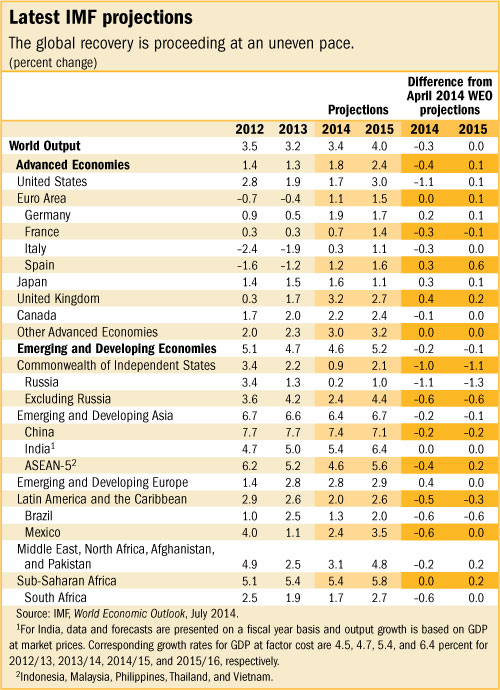
(Versions in Español, 中文, 日本語, Русский )
The recovery continues, but it remains weak, indeed a bit weaker than we forecast in April.
We have revised our forecast for world growth in 2014 from 3.7 percent in April to 3.4 percent today. This headline number makes things look worse than they really are. To a large extent, it reflects something that has already happened, namely the large negative US growth rate in the first quarter. But it is not all due to that. It also reflects a number of small downward revisions, both in advanced and in emerging economies.
The overall story remains largely the same as before:
Advanced economies are still confronted with high levels of public and private debt, which act as brakes on the recovery. These brakes are coming off, but at different rates across countries.
Emerging markets are slowing down from pre-crisis growth rates. They have to address some of their underlying structural problems, and take on structural reforms. At the same time, they have to deal with the implications of monetary policy normalization in the US.
Let me take you on the usual tour of the world.
Advanced economies
The United States
First quarter growth in the US, as currently reported (I would not be surprised if the numbers were revised), was far worse than anybody had anticipated. In retrospect, it seems to be largely due to one-off factors, ranging from an inventory correction to unusually bad weather. Looking forward, US growth for the rest of the year is still forecast to be 3.25 percent and 3 percent in 2015.
The main policy issue, at this juncture, is the appropriate speed of monetary policy normalization. Given the unusual behavior of labor participation, and uncertainty about the equilibrium rate of unemployment, assessing the amount of slack in the US is difficult. The current plans, namely the end of tapering later this year and increases in the policy rate from the middle of next year, are appropriate. But the timing of the increase in the policy rate may have to be adjusted, as a function of developments on the inflation and unemployment fronts.
A recent report by the BIS has drawn attention to the potential for excessive risk taking in financial markets coming from an extended period of low rates. We agree that, in some financial markets, valuations appear perhaps optimistic. But, overall, we do not see a systemic threat to financial stability, mainly because of lower leverage in both banks and, to the extent we can measure it, in non banks as well. Were the risks to increase however, macro prudential tools should be the right first line of defense. Getting ready to use them should be a policy priority.
The Euro area
The recovery in the Euro area remains weak, and inflation remains too low. Our forecasts for the Euro area remain roughly unchanged, 1.1 percent for 2014, and 1.5 percent for 2015. These numbers hide, however, differences across countries. In the core, we have revised our forecasts up for Germany, and down for France. In the periphery, we have revised our forecasts up for Spain, down for Italy.
To strengthen the recovery, the Euro area clearly still needs strong action on both the demand and the supply side:
In most Euro countries, unemployment rates far exceed their equilibrium value, and Euro wide inflation is too low. Thus, demand side policies are still of the essence. As fiscal space is tight, monetary policy must continue to support activity. The recent measures taken by the ECB are welcome. It is too early to assess their effects, and if inflation continued to remain stubbornly low, more measures should be considered.
Monetary policy cannot do the job alone however. The asset quality review currently under way in European banks is critical to reestablishing confidence in banks, and improving intermediation. And looking beyond the demand constraints, structural measures must be taken to increase very low potential growth rates. These measures differ across countries, ranging from reforms to re-enfranchise the unemployed youth, to measures that increase competition in non-tradable sectors, to infrastructure spending.
Japan
We have revised upwards our forecasts for Japan, to 1.6 percent in 2014. This reflects the effects of Abenomics, and stronger domestic demand, including investment. The fundamental challenge of Japan remains, how to decrease public debt and increase growth both in the short and the long run. Our forecast for 2015 gives a glimpse of the difficulty. Growth is forecast to be only 1.1 percent, reflecting in part the adverse effects on demand of the planned increase in consumption taxes later in the year.
Emerging market and developing economies
We forecast growth in emerging market and developing economies to run at 4.6 percent for 2014 (a revision down of 0.2 percent), and 5.2 percent for 2015 (a revision down of 0.1).
Our largest downward revision, relative to our WEO April forecast, is for Russia, where we have revised growth for 2014 from 1.3 percent to 0.2 percent, and for 2015 from 2.3 percent to 1 percent. This reflects mainly a deterioration of business confidence, which has been aggravated by geopolitical tensions. The result has led to large capital outflows, and a near freeze in investment decisions.
Housing investment has slowed down in China, and we expect this slowdown to continue. The government has counteracted this through a series of targeted stimulus measures directed at priority areas such as railway investment and social housing. Recent months have also seen higher credit flows and increasing infrastructure spending, as well as improving exports. Thus our forecast for this year is broadly unchanged at around 7½ percent growth. The main challenge for China remains however to achieve a more balanced growth, with less investment and more consumption.
Looking forward, emerging and developing economies face two challenges.
The first is to implement reforms to rebalance their economies and strengthen their growth. Some of these countries, Mexico notably, but others as well, are indeed embarking on ambitious reforms, which should help lift investment and growth.
The second is to adapt to a changing world environment. This change has already started. The recovery in advanced economies implies increased demand for their exports. The normalization of monetary policy in the United States, however, implies that some of the capital flows that went to emerging markets in search of higher returns will eventually return home. This in turn implies tighter financial conditions and a tougher financial environment. Foreign investors are less forgiving, macroeconomic weaknesses are more costly. And financial bumps, such as those we saw in May 2013, may well happen again.
In short, the recovery continues. But it remains weak, and is still in need of strong policy support, to strengthen both demand and supply.







